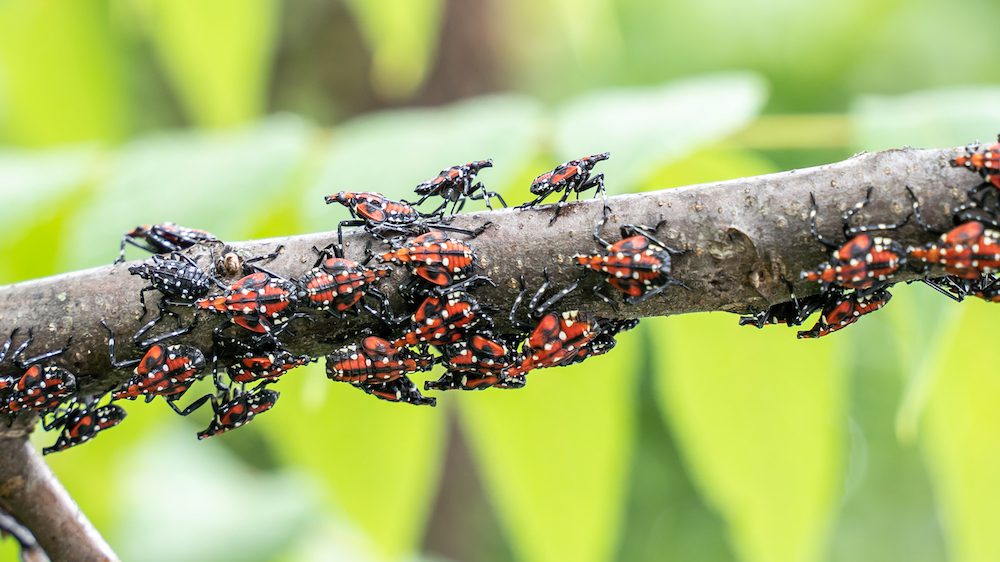
arlutz73/Getty Images
So far this year, we’ve seen the arrival of murder hornets, EEE-carrying mosquitoes, and zombie cicadas. Now, there’s another pest to add to your radar: the spotted lanternfly.
“The spotted lanternfly is a serious invasive pest with a healthy appetite for our plants,” says Heather Leach, a spotted lanternfly control expert with Penn State Extension. “It can be a significant nuisance, affecting the quality of life and enjoyment of the outdoors.”
Native to China and South Korea, the spotted lanternfly was first detected in Berks County, PA, in 2014. The bug is believed to have hitched a ride on shipment containers from China to Pennsylvania and has since spread to other states.
So, why should the spotted lanternfly be on your radar? It feeds on 70 different types of plants and trees, and can cause damage such as oozing sap, wilting, leaf curling, and tree dieback. That can spell bad news for the foliage around your house.
Here are ways you can help get a handle on this invasive pest and protect your beloved landscaping and garden.
Learn to spot it
Homeowners should be on the lookout for an insect that is 1 inch long and a half-inch wide, with spotted brown and red wings.
“This insect is an incredible hitchhiker,” says Brian Kunkel, extension specialist of ornamental integrated pest management at the University of Delaware. “Everyone needs to inspect their vehicles when traveling into or out of areas known to have this insect.”
In the fall the bugs can lay egg masses with 30 to 50 eggs each, according to the Pennsylvania Department of Agriculture. Egg masses look like light gray splotches of mud.
“Common places eggs are laid include flat surfaces like stones, picnic tables, benches, sheds, lawn furniture, decks, campers, cars, and trees, among many other locations,” says Kunkel.
Experts say you can remove egg masses by scraping them off surfaces into a container of alcohol.
Where is it a threat?

arlutz73/Getty Images
Most states are at risk, but the bug has been seen in Pennsylvania, Delaware, New Jersey, Maryland, West Virginia, New York, and Virginia. Use the spotted lanternfly map and reporting tool to see if you’re in an area where the pest has surfaced.
“Though they are not dangerous to humans—they do not bite or sting—they can cause damage to many trees and plants, including fruiting trees, black maple, and grape vines,” says Karen Verderame, animal programs developer at the Academy of Natural Sciences of Drexel University.
What’s at risk?
While the spotted lanternfly is harmless to humans, its spread could greatly affect the trees that are commonly found on residential properties.
Kunkel says the spotted lanternfly feeds on many trees, including maples, walnuts, sumac, willow, and oak. But its favorite is the tree of heaven, which is an invasive tree that is also native to China.
Experts say that as the spotted lanternfly feeds, it excretes honeydew, a sugary substance that can attract bees, wasps, and other insects. Honeydew also encourages the growth of sooty mold on infested plants.
“The spotted lanternfly produces honeydew throughout the year, but especially during the late summer and fall,” says Kunkel.
Report it
Verderame says there is no one easy way to deter or eliminate the spotted lanternfly, but it is important to be on the lookout for the pest.
“We need to limit the spread of this insect, and the best way for this to happen is for everyone to do their part,” says Kunkel.
Experts say if you happen to come across a spotted lanternfly, don’t just ignore it—squash it. Yes, you read that correctly: Squash it.
“If you find it in your yard, take a flyswatter or the bottom of your shoe to kill it,” says Leach. If you find the bug outside the zone that’s currently affected (in the Northeast), it’s important to report the finding so that it can be controlled before it has a chance to establish itself in the area.
Sightings can be reported to the Pennsylvania State University Extension, or call 1-888-4BAD-FLY (1-888-422-3359).
“If the spotted lanternfly is seen in another state, contact the state’s department of agriculture,” says Leach.
The post Beware the Spotted Lanternfly, the Latest Pest That Could Spell Bad News for Homeowners appeared first on Real Estate News & Insights | realtor.com®.
No comments:
Post a Comment